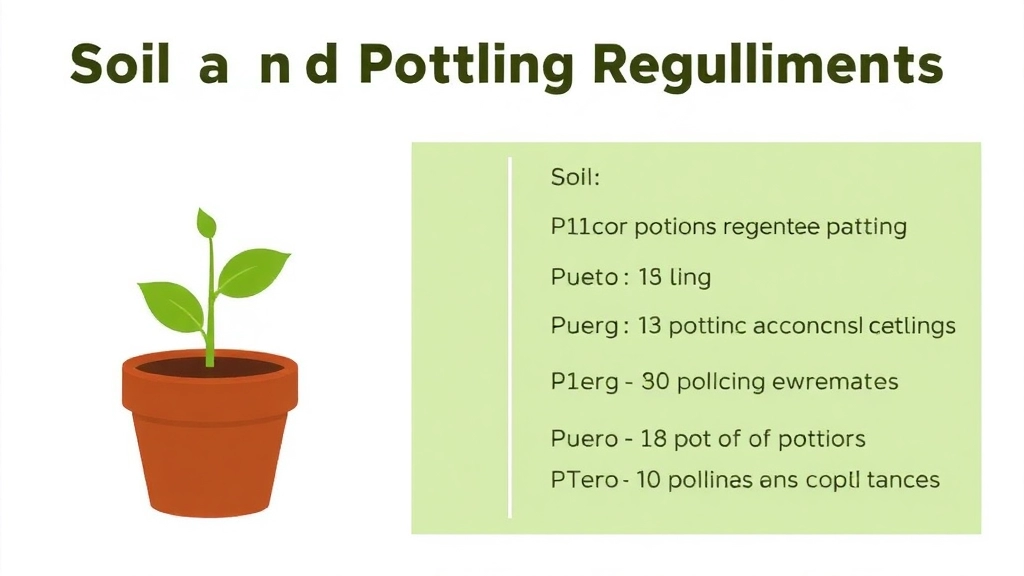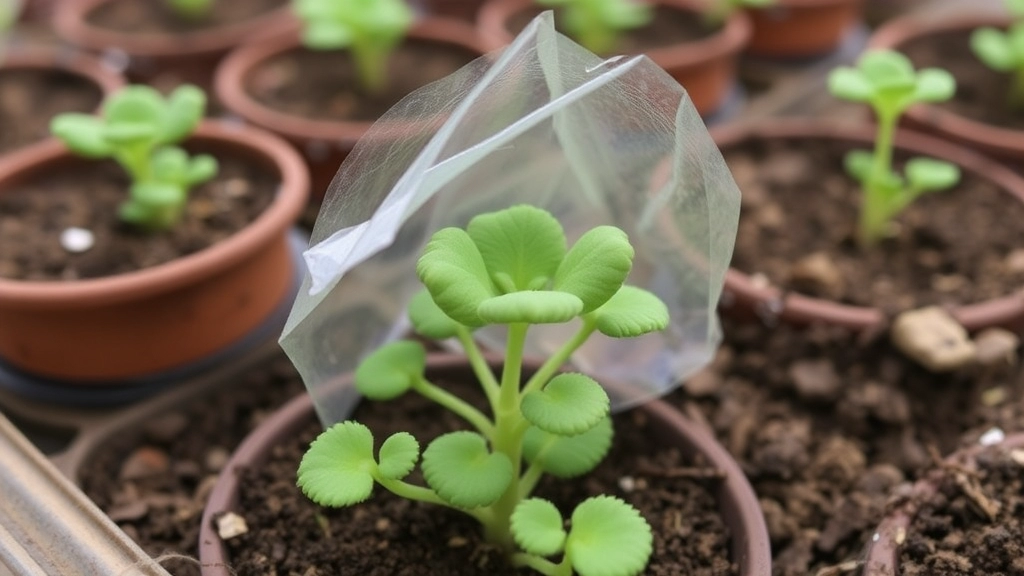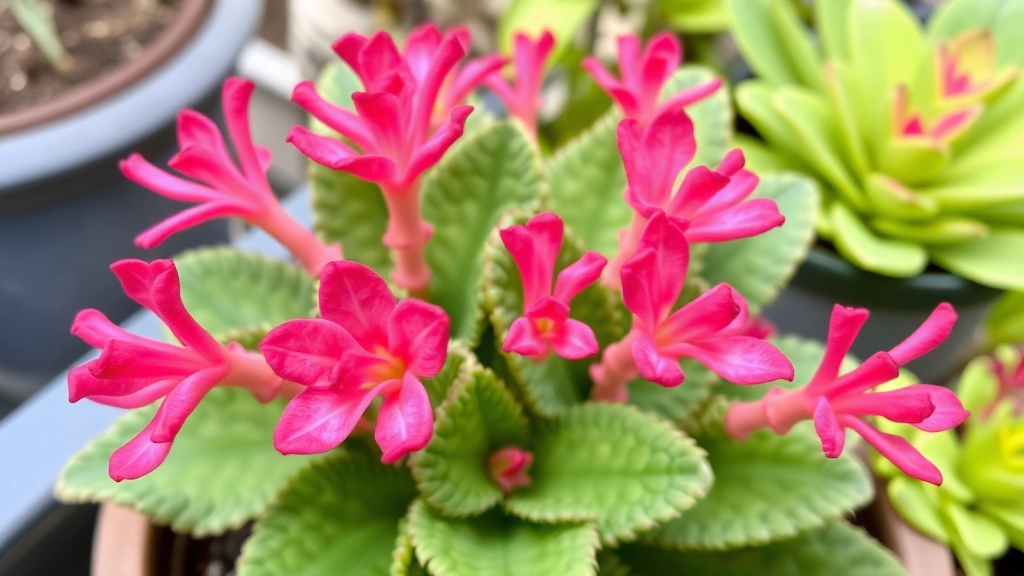Welcome to the Fascinating World of Kalanchoe Beharensis cv Fang
Welcome to the fascinating world of Kalanchoe beharensis cv fang, a truly extraordinary succulent that’s bound to captivate any plant enthusiast. This unique cultivar, with its massive, velvety leaves and distinctive tooth-like projections, is not just a plant – it’s a conversation starter. In this article, we’ll dive deep into the care, characteristics, and charm of this Madagascar native that’s taking the succulent world by storm.
From its ideal growing conditions to propagation techniques, we’ll cover everything you need to know to help your Kalanchoe beharensis cv fang thrive. Whether you’re a seasoned plant parent or a curious newcomer, get ready to discover why this ‘Felt Bush’ is more than just a pretty face in the succulent kingdom. Let’s embark on this green adventure together!
Overview of Kalanchoe Beharensis cv Fang
Ever stumbled upon a plant that looks like it’s from another planet? That’s Kalanchoe Beharensis cv Fang for you.
This bad boy is a real head-turner in the succulent world.
It’s not your average houseplant, trust me.
Kalanchoe Beharensis cv Fang, also known as “Felt Bush” or “Elephant’s Ear Kalanchoe,” is a unique cultivar.
It’s part of the Crassulaceae family, originating from Madagascar.
But here’s the kicker – the ‘Fang’ variety is a special cultivar with some extra oomph.
What makes it stand out? Those crazy, tooth-like projections on its leaves.
They’re not just for show – they give this plant its ‘Fang’ nickname.
The leaves are massive, velvety, and silvery-green. They can grow up to 1 foot long!
This plant isn’t just a pretty face – it’s tough as nails too.
It’s drought-tolerant and can handle a bit of neglect. Perfect for us forgetful plant parents, right?
But don’t let its rugged looks fool you. This plant can add a touch of exotic charm to any space.
Whether you’re a succulent newbie or a seasoned collector, Kalanchoe Beharensis cv Fang is worth checking out.
It’s a conversation starter, a low-maintenance friend, and a unique addition to your plant family.
So, ready to dive deeper into the world of this fanged beauty? Let’s go!
Distinctive Features and Characteristics
Let’s dive into what makes Kalanchoe Beharensis cv Fang stand out from the crowd. Trust me, this plant’s got some serious swagger!
First off, those leaves are something else. We’re talking massive, velvety triangles that look like they’ve been dipped in silver. They’re not just big; they’re HUGE, sometimes reaching up to 30cm long. And get this – they’re covered in these tiny, soft hairs that give them a fuzzy, almost alien-like texture.
But here’s where it gets really interesting:
- The ‘Fang’ in its name? That’s not just for show. The edges of the leaves have these little tooth-like projections that feel almost sharp to the touch.
- As the plant matures, it develops this gnarly, tree-like trunk that’s just begging to be shown off.
- The colour? It’s not your average green. We’re talking a silvery-grey that catches the light in all the right ways.
Now, let’s chat about size. This bad boy can grow up to 3-4 meters tall in its natural habitat. In your living room? Probably not that big, but still impressive enough to be a real conversation starter.
Here’s a quick rundown of its key features:
- Massive, triangular leaves
- Silvery-grey colouring
- Fuzzy texture
- Tooth-like leaf edges
- Tree-like trunk as it matures
But here’s the kicker – despite its exotic looks, this plant’s actually pretty chill to care for. It’s like that friend who looks high-maintenance but is actually super laid-back.
So, if you’re after a plant that’s going to turn heads and spark conversations, Kalanchoe Beharensis cv Fang is your guy. It’s got all the distinctive features and characteristics to make it a real standout in any plant collection. If you’re interested in other unique Kalanchoe varieties, you might want to check out the Kalanchoe orgyalis as well.
Ideal Growing Conditions
Let’s chat about the perfect setup for your Kalanchoe Beharensis cv Fang, shall we?
These quirky succulents are pretty chill, but they’ve got their preferences.
First up, they’re sun worshippers. Give ’em plenty of bright, indirect light.
But here’s the kicker – they can handle some direct sun too. Just ease them into it.
Temperature-wise, think warm and cosy. They’re not fans of the cold.
Aim for 15-27°C (59-80°F). That’s their sweet spot.
Humidity? Not a big deal. These guys are drought-tolerant champs.
But here’s a pro tip: good air circulation is key. Helps prevent fungal issues.
Outdoor or indoor? Both work, as long as you nail the basics.
In the garden, they’re show-stoppers. Just make sure the soil drains well.
Indoors, pop ’em near a bright window. South-facing is ideal in the UK.
Remember, these aren’t your average houseplants. They’re tough cookies.
Adapt to their needs, and they’ll reward you with stunning, otherworldly foliage.
So, ready to create the perfect home for your Kalanchoe Beharensis cv Fang?
Soil and Potting Requirements

Alright, let’s talk dirt â literally. When it comes to Kalanchoe Beharensis cv Fang, getting the soil and potting right is like setting the stage for a killer performance. Trust me, I’ve learned this the hard way.
So, what’s the secret sauce for these funky succulents?
The Dirt on Soil
First things first, these bad boys need well-draining soil. We’re talking:
- Cactus mix
- Succulent-specific soil
- Or a DIY blend of regular potting soil, perlite, and coarse sand
Why? Because Fang hates wet feet. Seriously, it’s like they’re wearing designer shoes and can’t stand getting them muddy.
Pot Like a Pro
Now, for the pot:
- Go for terracotta or unglazed ceramic
- Make sure it has drainage holes (non-negotiable)
- Size matters â choose a pot that’s just slightly larger than the root ball
Here’s a pro tip: Don’t go overboard with a massive pot. It’s tempting, I know, but trust me, Fang prefers to be a bit snug.
The pH Game
Fang isn’t too fussy about pH, but aim for slightly acidic to neutral (6.0-7.0). It’s like finding that sweet spot on your sofa â not too far left, not too far right.
Repotting Rhythm
How often should you repot? Well, it’s not a yearly party. These guys are slow growers, so every 2-3 years is plenty. And when you do, it’s like giving them a spa day â fresh soil, maybe a slightly bigger pot, and they’re good to go.
Remember, getting the soil and potting right for Kalanchoe Beharensis cv Fang is crucial. It’s the foundation for healthy growth, and trust me, when you nail this, your Kalanchoe will thank you with those awesome, textured leaves that make it a showstopper.
Watering and Fertilization Guidelines
Let’s chat about keeping your Kalanchoe Beharensis cv Fang happy and thriving.
Watering: The Golden Rule
First things first – these succulents are drought-tolerant champs.
Overwatering? That’s their kryptonite.
Here’s the deal:
- Water deeply, but infrequently
- Let the soil dry out completely between waterings
- In winter, cut back even more
Pro tip: Stick your finger in the soil. If it’s dry 2 inches deep, it’s watering time.
Fertilisation: Less is More
These guys aren’t big eaters. A light feed goes a long way.
Here’s what I do:
- Use a balanced, water-soluble fertiliser
- Dilute it to half strength
- Feed once a month during growing season
- Skip fertilising in winter
Remember: Over-fertilising can lead to leggy growth and weak plants.
The Watering Schedule Dance
Summer: Water every 7-10 days
Winter: Water every 3-4 weeks
But here’s the kicker – always check the soil first. Every plant’s different.
Drainage is Key
Make sure your pot has drainage holes.
Waterlogged soil? That’s a one-way ticket to root rot.
Signs of Overwatering:
- Yellowing leaves
- Soft, mushy stems
- Fungal growth on soil
Signs of Underwatering:
- Wrinkled, droopy leaves
- Slow growth
- Crispy leaf edges
Remember, it’s easier to save an underwatered Kalanchoe than an overwatered one.
Getting the watering and fertilisation right for your Kalanchoe Beharensis cv Fang might seem tricky at first, but once you get the hang of it, it’s a breeze.
Light and Temperature Preferences

Alright, let’s chat about what makes Kalanchoe Beharensis cv Fang tick when it comes to light and temp. Trust me, getting this right can be the difference between a thriving plant and one that’s just… meh.
Sun-loving succulents
These bad boys are sun worshippers, no doubt about it. They’re like that friend who’s always chasing the perfect tan. Here’s the deal:
- Full sun to partial shade is their sweet spot
- Aim for at least 6 hours of direct sunlight daily
- Morning sun is gentler, so it’s a good starting point
But hey, don’t go throwing them into scorching midday sun right off the bat. That’s a recipe for sunburn, and trust me, plant sunburn is just as ugly as human sunburn.
Temperature talk
Now, about temperature. These plants aren’t too fussy, but they’ve got their limits:
- They’re happy in temps between 10°C to 29°C (50°F to 85°F)
- Can handle brief dips to 4°C (40°F), but don’t push it
- Prefer it on the warmer side – they’re not big fans of cold snaps
Think of them as that mate who’s always complaining it’s too cold. They’d rather be basking in the heat than shivering in the shade.
Indoor vs outdoor vibes
If you’re keeping your Fang indoors (yeah, that’s what the cool kids call Kalanchoe Beharensis), here’s what you need to know:
- South-facing window? Perfect spot
- Not enough natural light? Grow lights are your new best friend
- Rotate the pot regularly to keep growth even
Outdoors, they’re pretty chill as long as you’re not in a freezing climate. Just remember, they’re not invincible. If frost is on the forecast, bring ’em inside or cover ’em up.
The bottom line? Kalanchoe Beharensis cv Fang loves the light and heat. Give ’em plenty of both, and they’ll reward you with those killer, fang-like leaves that give them their name. Just don’t go overboard – even sun-lovers can get too much of a good thing. If you’re interested in other varieties, you might want to check out the Kalanchoe Blossfeldiana colors for some vibrant options.
Common Pests and Diseases
Let’s chat about the not-so-fun part of growing Kalanchoe Beharensis cv Fang: pests and diseases.
Trust me, I’ve been there, and it’s no picnic.
But don’t worry, I’ve got your back.
Here’s the lowdown on what to watch out for:
Pesky Mealybugs
- These little cotton-like buggers love to feast on your Fang.
- They’re sneaky, hiding in leaf axils and stem joints.
- Spot ’em early, and you’re golden.
Root Rot: The Silent Killer
- Overwatering is the culprit here.
- Your Fang’s roots can’t handle sitting in soggy soil.
- It’s a common rookie mistake, but easily avoided.
Powdery Mildew: The White Menace
- This fungal infection looks like someone dusted your plant with flour.
- High humidity and poor air circulation are the usual suspects.
Spider Mites: Tiny Terrors
- These microscopic pests can wreak havoc if left unchecked.
- Look for fine webbing and stippled leaves.
Prevention is key, folks.
Keep your Fang healthy, and it’ll be more resistant to these issues.
Regular checks, proper care, and quick action when needed – that’s the secret sauce.
Remember, a healthy Kalanchoe Beharensis cv Fang is a happy Fang.
Stay vigilant, and your plant will thank you.
Propagation Techniques

Alright, let’s dive into how to make more of these funky Kalanchoe Beharensis cv Fang plants. Trust me, it’s not rocket science, and you’ll be a pro in no time.
Leaf Cuttings: The Easy Way
Here’s the deal:
- Snip off a healthy leaf
- Let it dry for a day or two (yeah, just leave it out)
- Stick it in some well-draining soil
- Water lightly and wait
Boom! In a few weeks, you’ll see tiny plants popping up. It’s like magic, but it’s just plant science doing its thing.
Stem Cuttings: For the Overachievers
Want to go big? Try this:
- Cut a 4-6 inch stem
- Remove lower leaves
- Let it callous over for a couple days
- Plant in a pot with good drainage
- Keep it warm and slightly moist
Before you know it, roots will sprout, and you’ll have a mini Fang ready to grow.
Division: The Splitting Technique
Got a big plant? Lucky you! Here’s what you do:
- Carefully remove the plant from its pot
- Gently separate the roots into sections
- Replant each section in its own pot
It’s like giving your plant buddies to hang out with. They’ll thank you by growing even more.
Seeds: The Patient Person’s Game
Honestly? It’s rare to find Fang seeds, and they’re a pain to grow. But if you’re feeling adventurous:
- Sow seeds on top of soil
- Keep them warm and moist
- Wait… and wait some more
It’ll take forever, but hey, if you’ve got the patience of a saint, go for it.
Remember, propagation is all about experimenting. Some cuttings might not make it, and that’s cool. It’s part of the learning process. Just keep at it, and soon you’ll have Fangs all over the place.
And there you have it â propagation techniques for Kalanchoe Beharensis cv Fang. Give it a shot, and watch your plant family grow! If you’re interested in other unique Kalanchoe varieties, check out the Kalanchoe Tomentosa, also known as the Panda Plant, for a fuzzy and fun addition to your collection.
Pruning and Maintenance Tips
Let’s chat about keeping your Kalanchoe Beharensis cv Fang looking fab, shall we?
Pruning this beauty isn’t rocket science, but it does need a bit of TLC.
First things first: grab those clean, sharp pruning shears.
Why? ‘Cause we don’t want to spread any nasties to our plant pal.
Now, when should you prune?
Typically, spring or early summer’s your best bet.
But hey, if you spot any dead or yellowing leaves, snip ’em off anytime.
Here’s a quick rundown of pruning dos:
- Cut back leggy stems to encourage bushier growth
- Remove any crossing or rubbing branches
- Trim off spent flower stalks to keep things tidy
But wait, there’s more to maintenance than just pruning!
Keep an eye out for dust on those big, fuzzy leaves.
A gentle wipe with a damp cloth every now and then works wonders.
And don’t forget to rotate your plant regularly for even growth.
Fancy a bushier Fang? Pinch off the growing tips occasionally.
It’s like giving your plant a little haircut – it’ll bounce back fuller than ever.
Remember, less is more when it comes to pruning Kalanchoe Beharensis cv Fang.
You don’t want to go all Edward Scissorhands on it, right?
Just a little snip here and there, and your Fang will be thriving in no time.
Uses in Landscaping and Indoor Decor
Let’s chat about how to make the most of Kalanchoe Beharensis cv Fang in your space. This plant’s a real showstopper, and I’ve got some killer ideas on how to use it.
Outdoor Landscaping: Making a Statement
When it comes to outdoor landscaping, Fang’s not messing around. Here’s how I’ve seen it shine:
- Focal Point: Plop it in the centre of a rock garden or succulent display. Trust me, it’ll grab attention.
- Border Plant: Line a pathway or driveway with these bad boys. They’ll create a unique, textured edge.
- Container Gardening: Stick it in a big, stylish pot on your patio or balcony. It’ll be the talk of your next BBQ.
Indoor Decor: Bringing the Wow Factor Inside
Don’t think Fang’s just an outdoor plant. It can work wonders indoors too:
- Statement Piece: Put it in a corner of your living room or office. It’s like living art, I swear.
- Shelf Accent: Got a bookshelf? Stick a smaller Fang between your reads for a pop of green.
- Bathroom Buddy: If you’ve got a bright bathroom, Fang can handle the humidity like a champ.
Pairing with Other Plants
Fang plays well with others, but you’ve got to choose its mates wisely:
- Contrast is Key: Pair it with smoother-leaved plants like Jade or Echeveria for a textural mix.
- Color Coordination: Its silvery-green leaves look ace next to plants with purple or red hues.
Pro Tip: Remember, Fang’s a bit of a diva when it comes to light. Make sure it’s getting enough sun wherever you put it.
Maintenance in Landscaping and Decor
Look, Fang’s not high-maintenance, but it’s not a “set it and forget it” deal either:
- Regular Dusting: Those fuzzy leaves can collect dust. Give ’em a gentle wipe now and then.
- Rotation: If it’s indoors, rotate the pot every few weeks to keep growth even.
- Space to Grow: This plant can get big, so give it room to spread its wings.
At the end of the day, Kalanchoe Beharensis cv Fang is a versatile player in both landscaping and indoor decor. Whether you’re aiming for a desert vibe or just want to add some texture to your space, Fang’s got your back. Just remember its light needs, give it some TLC, and watch it become the star of your green show.
FAQs about Kalanchoe Beharensis cv Fang
1. What makes Kalanchoe Beharensis cv Fang unique?
Kalanchoe Beharensis cv Fang stands out due to its distinctive tooth-like projections on the leaf edges, giving it the ‘Fang’ nickname. It also has large, velvety, silvery-green leaves that can grow up to 1 foot long.
2. How often should I water my Kalanchoe Beharensis cv Fang?
Water your Fang deeply but infrequently. Allow the soil to dry out completely between waterings. In summer, this might mean watering every 7-10 days, while in winter, you can reduce to every 3-4 weeks.
3. Can Kalanchoe Beharensis cv Fang be grown indoors?
Yes, it can be grown indoors. Place it near a south-facing window for optimal light. If natural light is insufficient, consider using grow lights to supplement.
4. What type of soil is best for Kalanchoe Beharensis cv Fang?
Use well-draining soil, such as a cactus mix or a blend of regular potting soil, perlite, and coarse sand. This helps prevent water-logging, which can lead to root rot.
5. How do I propagate Kalanchoe Beharensis cv Fang?
You can propagate Fang through leaf cuttings, stem cuttings, or division. Leaf cuttings are the easiest method – simply let a healthy leaf callous over for a few days, then plant it in well-draining soil.
6. Is Kalanchoe Beharensis cv Fang toxic to pets?
While not highly toxic, it’s best to keep Kalanchoe plants away from pets as ingestion can cause mild gastrointestinal upset. Always consult with a vet if you suspect your pet has eaten any part of the plant.
7. How big can Kalanchoe Beharensis cv Fang grow?
In its natural habitat, it can grow up to 3-4 meters tall. However, when grown as a houseplant, it typically remains much smaller, usually reaching 1-2 meters in height.
8. How often should I fertilize my Kalanchoe Beharensis cv Fang?
Fertilize once a month during the growing season with a balanced, water-soluble fertilizer diluted to half strength. Skip fertilizing in winter when growth slows down.
References
-
Missouri Botanical Garden – Kalanchoe beharensis Kalanchoe beharensis
-
World of Succulents – Kalanchoe beharensis “Fang” Kalanchoe beharensis “Fang”

